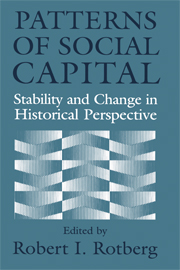Book contents
- Frontmatter
- Contents
- Introduction Social Capital and Political Culture in Africa, America, Australasia, and Europe
- Articles
- Civic Traditions in Premodern Italy
- The Sources of Civil Society in Italy
- Finding Social Capital: The French Revolution in Italy
- Social Capital in the Early Industrial Revolution
- The Diversity of Social Capital in English Communities, 1300–1640 (with a Glance at Modern Nigeria)
- Social and Cultural Capital in Colonial British America: A Case Study
- The Growth of Voluntary Associations in America, 1840–1940
- Civil Society as Democratic Practice: North American Cities during the Nineteenth Century
- Securing Political Returns to Social Capital: Women's Associations in the United States, 1880s–1920s
- Second-Generation Civic America: Education, Citizenship, and the Children of Immigrants
- Human Capital and Social Capital: The Rise of Secondary Schooling in America, 1910–1940
- From Local to National Political Cultures: Social Capital and Civic Organization in the Great Plains
Civic Traditions in Premodern Italy
Published online by Cambridge University Press: 12 April 2010
- Frontmatter
- Contents
- Introduction Social Capital and Political Culture in Africa, America, Australasia, and Europe
- Articles
- Civic Traditions in Premodern Italy
- The Sources of Civil Society in Italy
- Finding Social Capital: The French Revolution in Italy
- Social Capital in the Early Industrial Revolution
- The Diversity of Social Capital in English Communities, 1300–1640 (with a Glance at Modern Nigeria)
- Social and Cultural Capital in Colonial British America: A Case Study
- The Growth of Voluntary Associations in America, 1840–1940
- Civil Society as Democratic Practice: North American Cities during the Nineteenth Century
- Securing Political Returns to Social Capital: Women's Associations in the United States, 1880s–1920s
- Second-Generation Civic America: Education, Citizenship, and the Children of Immigrants
- Human Capital and Social Capital: The Rise of Secondary Schooling in America, 1910–1940
- From Local to National Political Cultures: Social Capital and Civic Organization in the Great Plains
Summary
In the fifth chapter of Making Democracy Work, Putnam argues that the origins of civic society in modern Italy can be traced back to the age of the communes (twelfth to fifteenth centuries) in its northern and central regions. The distinctive features of those republican regimes were a high degree of cooperation and collaboration among their members, an atmosphere of mutual trust essential for their survival and the achievement of common goals, and an egalitarian ethos based upon horizontal social bonds. The associative impulse that led to the establishment of the communes also inspired the creation of other civic organizations: tower societies; guilds, Guelf and Ghibelline “parties”; and confraternities. The contrast between the political and social structures of the feudal world, from which these associations emerged, was dramatic. In those parts of the peninsula that were not intensely urbanized—Piedmont and the Appennine region—or dominated by a strong, centralized monarchy—like the towns in the south—a social structure based upon vertical relationships survived intact.
Putnam admits that the civic ethos of the communal world was weakened in the decades following the Black Death, and particularly after the foreign invasions and the hegemony established in the sixteenth century by Hapsburg Spain. Still, he insists that the values and ideals of the communal era survived into the modern age of the Risorgimento and unification: “In the North, norms of reciprocity and networks of civic engagement have been embodied in tower societies, guilds, mutual aid societies, cooperatives, unions and even soccer clubs and literary societies.”
- Type
- Chapter
- Information
- Patterns of Social CapitalStability and Change in Historical Perspective, pp. 19 - 40Publisher: Cambridge University PressPrint publication year: 2000
- 1
- Cited by



